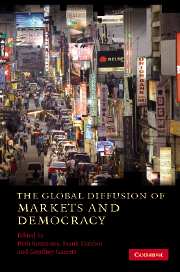Book contents
- Frontmatter
- Contents
- List of appendixes
- List of figures
- List of tables
- Notes on contributors
- Acknowledgements
- 1 Introduction: the diffusion of liberalization
- 2 Tax policy in an era of internationalization: an assessment of a conditional diffusion model of the spread of neoliberalism
- 3 The decision to privatize: economists and the construction of ideas and policies
- 4 The international diffusion of public sector downsizing: network emulation and theory-driven learning
- 5 Global ideology and voter sentiment as determinants of international financial liberalization
- 6 Competing for capital: the diffusion of bilateral investment treaties, 1960–2000
- 7 Diffusion and the spread of democratic institutions
- 8 World society and human rights: an event history analysis of the Convention on the Elimination of All Forms of Discrimination against Women
- 9 Conclusion
- Index
- References
5 - Global ideology and voter sentiment as determinants of international financial liberalization
Published online by Cambridge University Press: 04 August 2010
- Frontmatter
- Contents
- List of appendixes
- List of figures
- List of tables
- Notes on contributors
- Acknowledgements
- 1 Introduction: the diffusion of liberalization
- 2 Tax policy in an era of internationalization: an assessment of a conditional diffusion model of the spread of neoliberalism
- 3 The decision to privatize: economists and the construction of ideas and policies
- 4 The international diffusion of public sector downsizing: network emulation and theory-driven learning
- 5 Global ideology and voter sentiment as determinants of international financial liberalization
- 6 Competing for capital: the diffusion of bilateral investment treaties, 1960–2000
- 7 Diffusion and the spread of democratic institutions
- 8 World society and human rights: an event history analysis of the Convention on the Elimination of All Forms of Discrimination against Women
- 9 Conclusion
- Index
- References
Summary
Introduction
Scholars have long argued that the spread of ideas and values matters for the adaptation and reform of government policies. (See, for example, the essays in Hall 1989.) In this chapter, we investigate whether and how either liberal or restrictive international financial policies on capital account regulation spread globally, both through the direct effects of changes in global ideology on government policy and indirectly, through policy diffusion between other states.
In the following sections we: (1) provide a detailed account of the mechanisms of diffusion, focusing on the theoretical basis for the global, grassroots spread of ideas that affect government policies; (2) identify valid indicators of ideological change that will aid in identifying the mechanisms through which it is diffused; (3) discuss our models and methods, focusing on how ideology is diffused indirectly and globally through influence on other governments' policies; and (4) report the results of our study, and offer concluding remarks.
How ideas spread
While global convergence toward political and economic liberalism might be a defining story of the last two decades of the twentieth century, we find scant evidence that convergence around a particular set of policies regarding capital account liberalization is consistent over time or space. During the entire twentieth century, many distinct waves of international financial openness and closure diffused worldwide.
Based upon the work of many scholars, we know many of the domestic and international political and economic forces that account for change in international financial openness.
- Type
- Chapter
- Information
- The Global Diffusion of Markets and Democracy , pp. 173 - 219Publisher: Cambridge University PressPrint publication year: 2008
References
- 3
- Cited by



